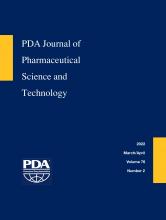Research ArticleResearch
National Economic and Environmental Benefit of Reusable Textiles in Cleanroom Industry
Michael Overcash and Evan Griffing
PDA Journal of Pharmaceutical Science and Technology March 2022, 76 (2) 109-119; DOI: https://doi.org/10.5731/pdajpst.2020.012138
Michael Overcash
1Environmental Genome Initiative, 2908 Chipmunk Lane, Raleigh, NC 27607;
Evan Griffing
2Environmental Clarity, Inc., 2505 Fauquier Lane, Reston, VA 20191

References
- 1.↵Centers for Disease Control and Prevention. CDC/HICPAC Guidelines for Environmental Infection Control in Health-Care Facilities. Centers for Disease Control and Prevention and the Healthcare Infection Control Practices Advisory Committee Web site. https://www.cdc.gov/hicpac/pdf/guidelines/eic_HCF_03.pdf (accessed April 2020).
- 2.↵
- Glosson S.
- 3.↵
- Alshqaqeeq F.,
- Griffing E.,
- Twomey J.,
- Overcash M.
- 4.↵
- Vozzola E.,
- Overcash M.,
- Griffing E.
- 5.↵
- Vozzola E.,
- Overcash M.,
- Griffing E.
- 6.↵
- Overcash M.
- 7.↵
- McDowell J. W.
- 8.↵European Textile Service Association. Simplified Life Cycle Assessment of Surgical Gowns. ETSA: Brussels, Belgium, 2000.
- 9.↵
- Carre A.
- 10.↵
- Van den Berghe A.,
- Riegel A.,
- Zimmer C.
- 11.↵UniTech Corp. Life Cycle Inventory Comparison of Radiological Protective Garments. UniTech Corp: Springfield, MA, 2010.
- 12.↵
- Vozzola E.,
- Overcash M.,
- Griffing E.
- 13.↵
- 14.↵
- 15.↵
- Gruendemann B.
- 16.↵
- DiGiacomo J. C.,
- Odom J. W.,
- Ritota P. C.,
- Swan K. G.
- 17.↵
- Baykasoğlu A.,
- Dereli T.,
- Yılankırkan N.
- 18.↵
- Rossington K.
- 19.↵
- Clarke G.
- 20.↵
- Maurer D.,
- Donelle R.
- 21.↵
- Rossington K.
- 22.↵
- 23.↵U.S. Price of Landfilling Municipal Waste by Region 2018, Statista Web site. https://www.statista.com/statistics/692063/cost-to-landfill-municipal-solid-waste-by-us-region/ (accessed August 2019).
- 24.↵
- 25.↵
- Scarborough P.,
- Appleby P. N.,
- Mizdrak A.,
- Briggs A. D. M.,
- Travis R. C.,
- Bradbury K. E.,
- Key T. J.
- 26.
- Deiterich A.
- 27.↵U.S. Environmental Protection Agency. Greenhouse Gas Emissions from a Typical Passenger Vehicle. Office of Transportation and Air Quality. EPA-420-F-11-041. http://www.epa.gov/otaq/climate/documents/420f11041.pdf
- 28.↵
- Apfalter P.
- 29.↵
- Mittermayer H.
- 30.↵
- Mekjavic L.,
- Banister E. W.,
- Morrison J. B.
- Umbach K.
- 31.↵International Organisation for Standardization, ISO 11092 (1993), Textiles, Physiological Effects, Measurement of Thermal and Water-Vapor Resistance Under Steady-State Conditions (Sweating Guarded-Hotplate Test), ISO: Geneva, 1993.
- 32.↵
In This Issue
PDA Journal of Pharmaceutical Science and Technology
Vol. 76, Issue 2
March/April 2022
National Economic and Environmental Benefit of Reusable Textiles in Cleanroom Industry
Michael Overcash, Evan Griffing
PDA Journal of Pharmaceutical Science and Technology Mar 2022, 76 (2) 109-119; DOI: 10.5731/pdajpst.2020.012138
Jump to section
Related Articles
- No related articles found.
Cited By...
- No citing articles found.





